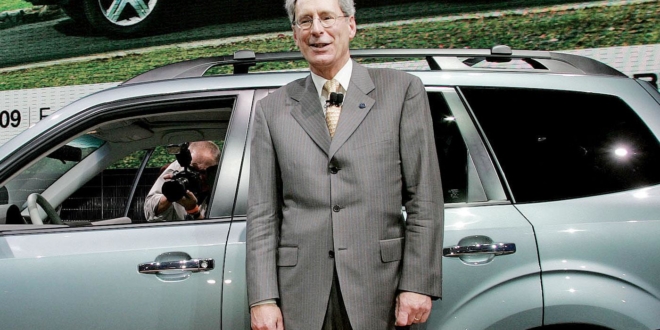
Doll: Subaru’s struggles in the 1990s helped prepare it for the Great Recession.
As Tom Doll watches planes land at Philadelphia International Airport from a window at Subaru of America’s new headquarters in Camden, N.J., he’s reminded of what was going on at the company a decade ago.
“That was us,” says the CEO, referring to the planes stacked up for landing. “In 2007, 2008 and 2009, Impreza, Forester and Outback were coming in for runways, and we knew we had to get those planes down. If we did, we were going to be successful. We had to push ourselves through it. It was our shot.”
Subaru defied the odds of the Great Recession. It was the only mainstream automaker to post sales increases through the worst days of the recession.
But like everyone else, Subaru felt the pressure when Lehman Bros. collapsed on Sept. 15, 2008.
Doll was on a business trip.
“I remember being on a plane, going to Portland to visit some retailers on that Monday when it all started to come down,” he says. “I arrived in Portland and I saw all these people gathered around a television screen. I remember immediately finding out what was going down, getting on the plane and coming back.”
“It was scary times. I don’t think people around the country at the time really knew how, effectively, commerce kind of stopped for like four or five hours during that day as banks were trying to shore up their liquidity positions. We were lucky from the standpoint that we had Chase as our financial partner [and] Subaru Motors Finance, and so we just went right through it.”
Doll’s message to retailers was to stay calm, stay the course and don’t fire salespeople, administrative staff or technicians.
“We stuck to our knitting,” he says. “We didn’t panic. It was tough because some retailers, as well as some people in our sales and marketing departments at the time, were saying, ‘Geez, we’ve got to make sure we push these cars through the system. So, let’s go back to the way we had been doing things. We’ve got better products, but did we maybe need to incentivize them?’ There was a great tendency to do that. But we had to say, ‘no, no, no.’ ”
It turned out that the years when Subaru struggled in the U.S. market prepared the company for the Great Recession.
“In many respects, what we went through in the financial crisis years was kind of nothing compared to what we went through in the early 1990s through the mid-1990s,” Doll says.
Memories of bloated inventories and U.S. sales totals barely cracking 100,000 vehicles hadn’t gone away.
But above all, what aided Subaru the most during the Great Recession were those vehicles coming in for a landing. Subaru was one of the pioneers in the crossover segment in the 1990s. By the time the economic crisis was in full swing, it had brought out its latest and best efforts in those categories.
Parent Subaru Corp., then known as Fuji Heavy Industries, had redesigned nameplates that were bigger and better looking. Most importantly, the vehicles were tailored to U.S. customers.
“We had great fuel economy and great utility in our cars,” Doll says. “People were downsizing from larger trucks and SUVs, and they were moving into the products that we had.”
In 2008, Subaru’s U.S. sales totaled 187,699 vehicles. In 2009, the number grew — to 216,652. By 2010, sales had jumped to 263,820. Subaru was defying gravity. Last year, the company’s volume hit 647,956. Its market share has risen from 1.4 percent in 2008 to 3.8 percent last year.
“When we were small, we weren’t as important, perhaps, to the overall retailer’s financial well-being,” Doll said. “They could afford to take a leap of faith. “They said ‘OK, we’ll see what happens.’ Obviously, they’re happy they did and so are we. You have to have a partnership with your retailers in these difficult times.”
